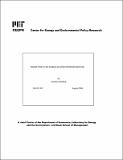| dc.contributor.author | Sweeting, Andrew | en_US |
| dc.contributor.other | Massachusetts Institute of Technology. Center for Energy and Environmental Policy Research. | en_US |
| dc.date.accessioned | 2009-04-03T17:06:12Z | |
| dc.date.available | 2009-04-03T17:06:12Z | |
| dc.date.issued | 2004 | en_US |
| dc.identifier | 2004-013 | en_US |
| dc.identifier.uri | http://hdl.handle.net/1721.1/45021 | |
| dc.description.abstract | This paper shows that generators exercised increasing market power in the England and Wales wholesale electricity market in the second half of the 1990s despite declining market concentration. It examines whether this was consistent with static, non-cooperative oligopoly models, which are widely used to model electricity markets, by testing the static Nash equilibrium assumption that each generator chose its bids to maximize its current profits taking the bids of other generators as given. It finds a significant change in behavior in late 1996. In 1995 and 1996 generator behavior was consistent with the static Nash equilibrium assumption if the majority of their output was covered by financial contracts which hedged prices. After 1996 their behavior was inconsistent with the static Nash equilibrium assumption given their contract cover but it was consistent with tacit collusion. | en_US |
| dc.format.extent | 33, [11] p | en_US |
| dc.publisher | MIT Center for Energy and Environmental Policy Research | en_US |
| dc.relation.ispartofseries | MIT-CEEPR (Series) ; 04-013WP. | en_US |
| dc.title | Market power in the England and Wales wholesale electricity [market, 1995-2000] | en_US |
| dc.type | Working Paper | en_US |
| dc.identifier.oclc | 57673097 | en_US |
